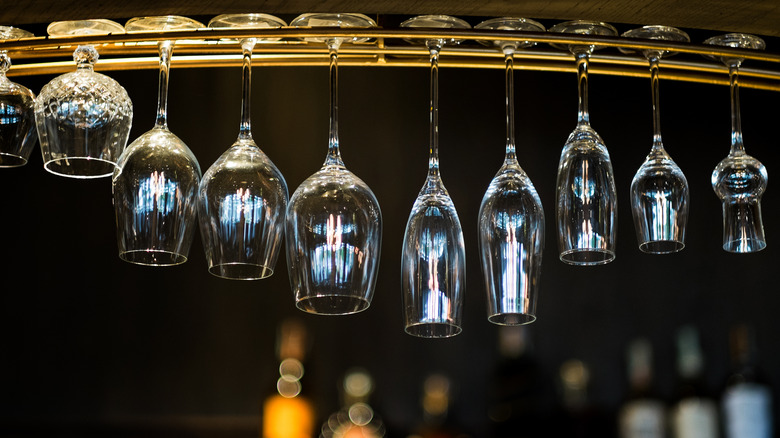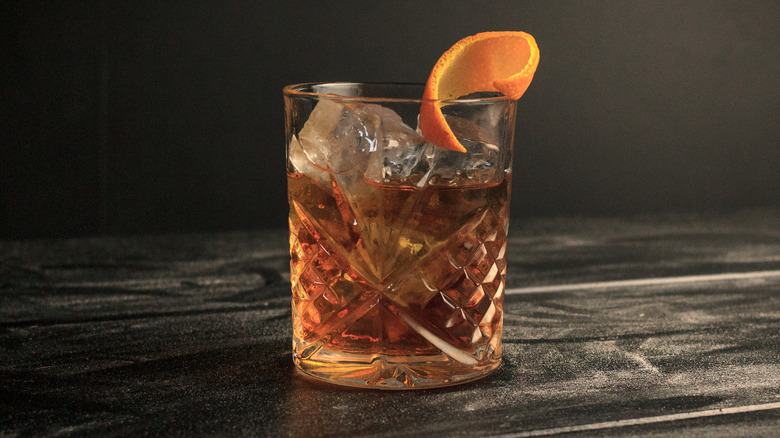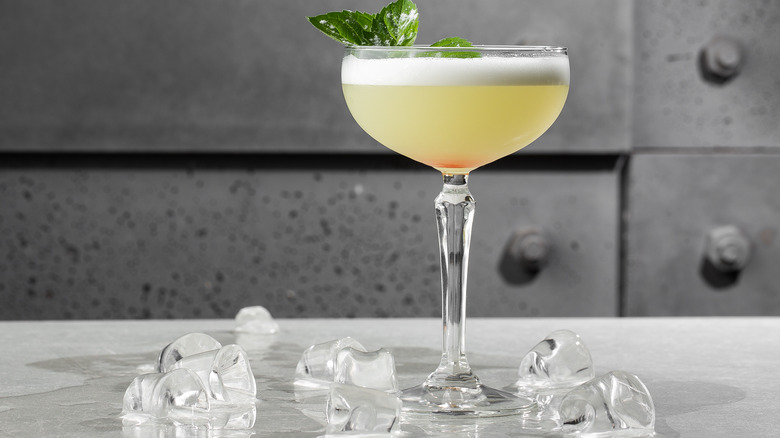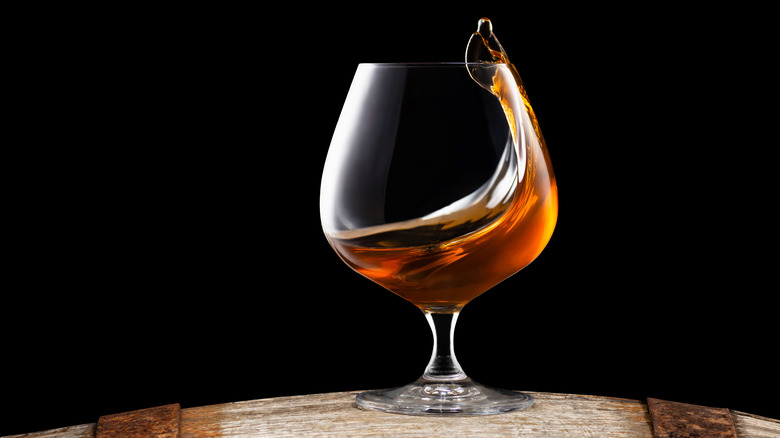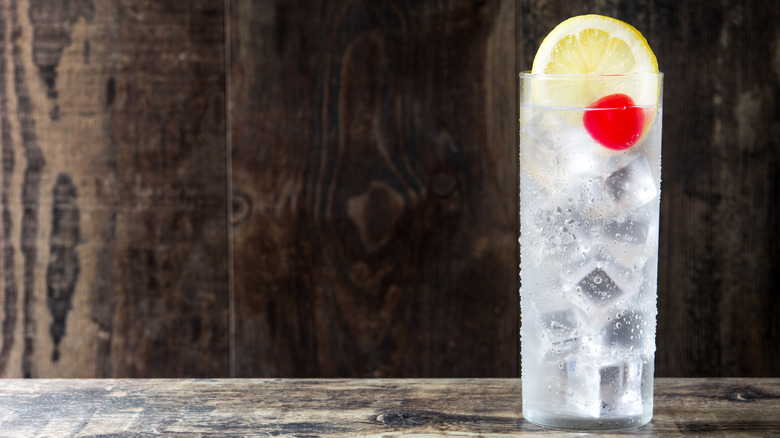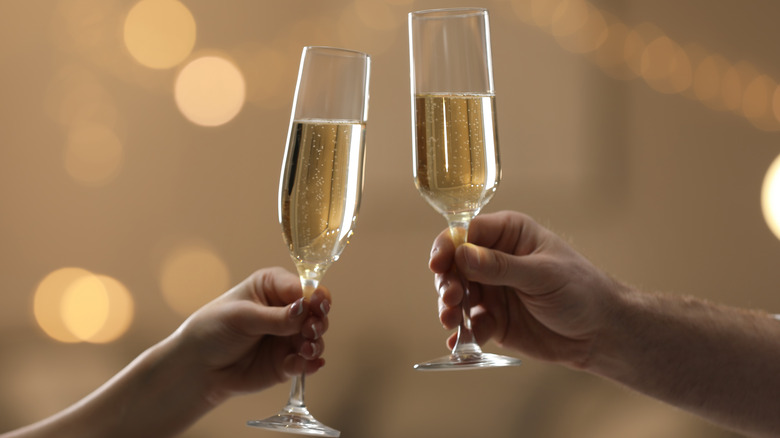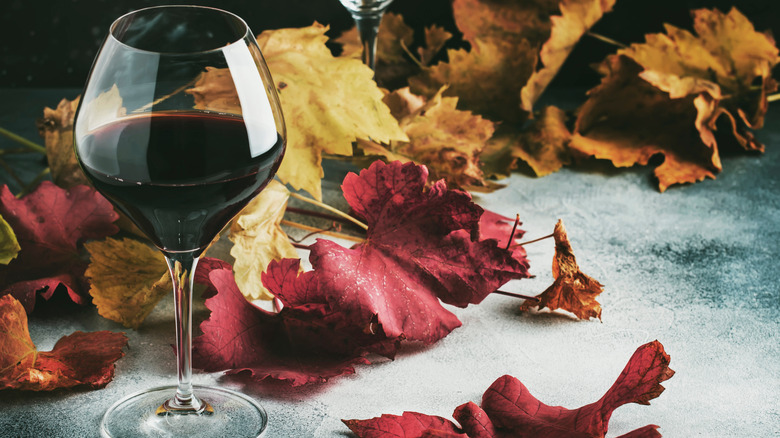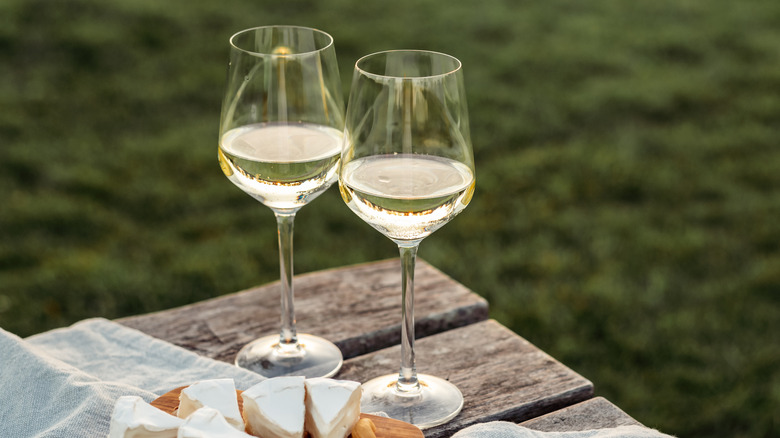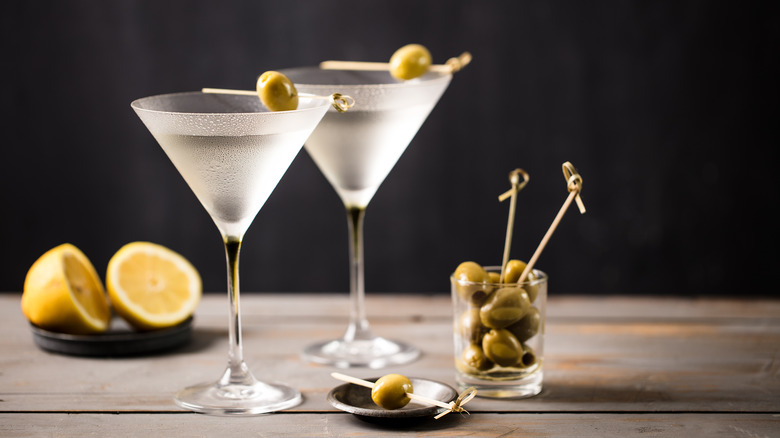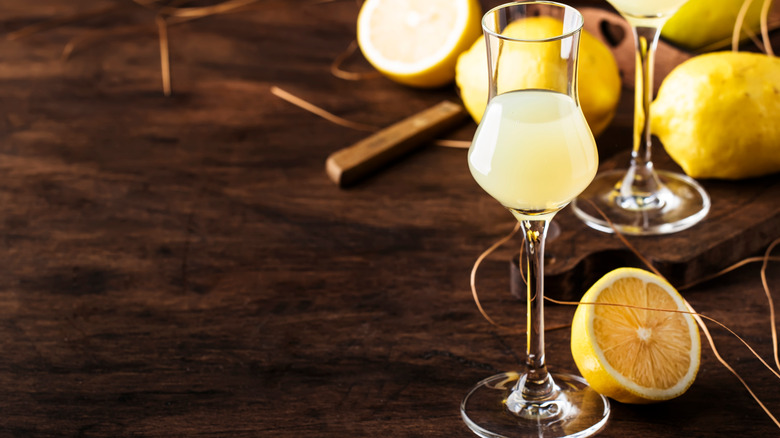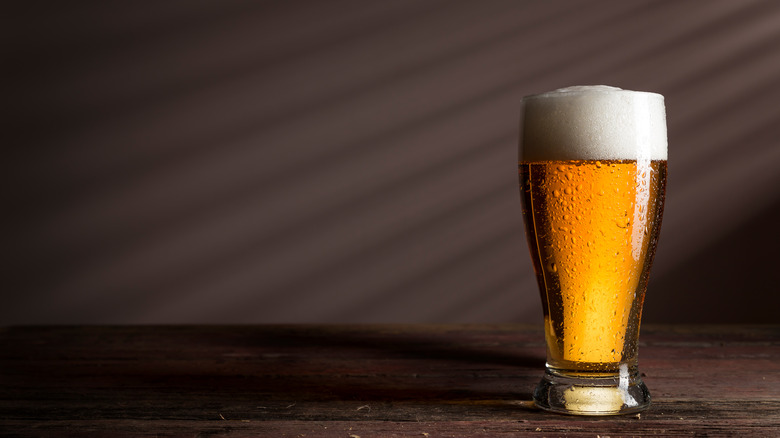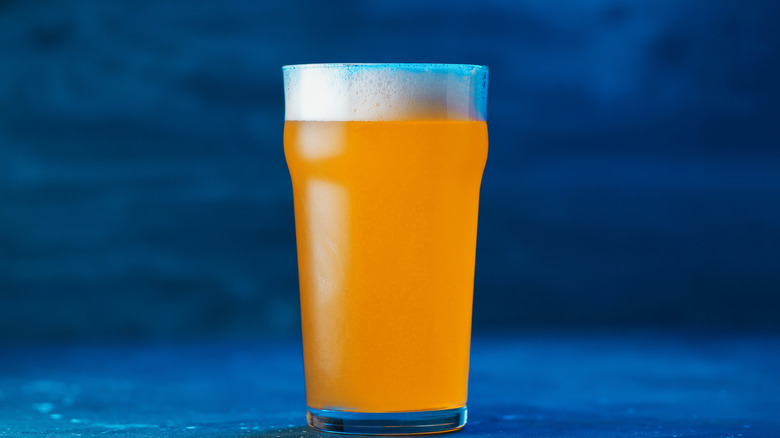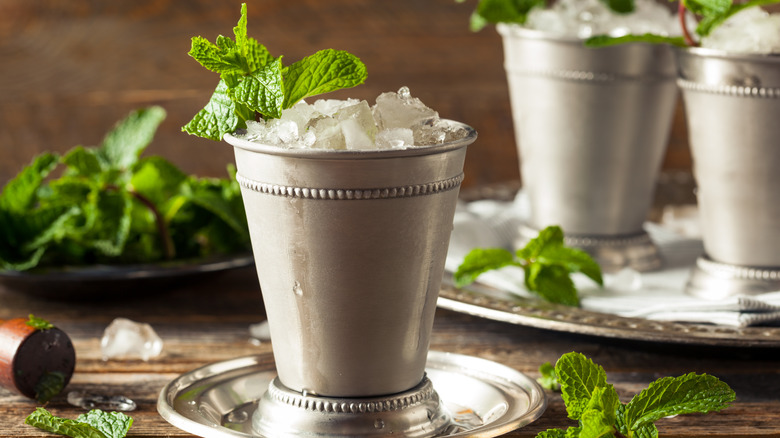Types Of Glassware And What They're Used For
There are practically as many types of glassware as there are different varieties of drinks to put in them. There are traditional choices for specific types of beverages and there are whimsical, silly options too. While some folks might get their haunches up about what glass you pour their cocktail into, most people go about their day without thinking too much about it. Neither approach is incorrect, obviously, but it is rewarding to at least be able to make an informed decision.
One of the most important aspects of glassware, that comes up again and again, is its shape. Wine glasses, in particular, are singled out for their use based on the proportions of their curves (or lack thereof) and how that influences the enjoyment of their contents. Generally speaking, a narrow rim traps precious aromas in the glass and allows for a more complete appreciation of the wine. This applies to other glasses as well and many beer glasses are conceived with this in mind.
It's silly to pretend that you must always have the exact correct glass for any given drink. However, it can also be a lot of fun to go to the effort to ensure you are getting the optimal experience. Glasses are also very decorative and can form a stunning display in your home or bar, so keep in mind that this guide can also help you beautify your environment even as it assists you in choosing the right glass for your drink.
Rocks glass
This straightforward glass is a mainstay at bars the world over. Its unfussy shape and widespread availability mean that this is usually the default for a pour of straight liquor for sipping. However, many traditional mixed drinks are served — and even made (via the Spruce Eats) — in this glass. In fact, it's often referred to as an Old Fashioned Glass after the most famous drink traditionally served from it, so-called because it emulates the original formula for a cocktail: spirits, sugar, bitters, and water. Ideally, the glass has a heavy base that helps the drink to remain at the perfect chilled temperature for a long time.
Most drinks in this glass will be served over ice or "on the rocks” — hence the name. The connoisseur's choice is typically to have one large cube in the glass. According to Epicurious, this keeps the drink cold but slows down the dilution process that can happen too quickly when lots of smaller ice cubes are used.
There are also different sized variations of this glass, usually called "single" or "double," depending on the capacity. Bevvy advises using a smaller size since it is more versatile. The classic version is a cut crystal glass which, in addition to adding decorative elements, makes for a grippier surface that can make you feel more secure as you're sipping on your Negroni.
Coupe
Coupes were initially conceived as a sophisticated way to sip champagne. More recently, however, wine experts have come to agree that the wide surface of these shallow glasses allow too many of champagne's precious bubbles to dissipate, taking with them a great deal of aroma, not to mention charm, as summarized by the Huffington Post.
However, these shallow vessels have had new life breathed into them by the modern cocktail renaissance as bartenders turn to them as a perfect container for cocktails served "up" – or chilled but without ice. The stem keeps hot hands away from the drink and prevents things from getting too warm too quickly (via Advanced Mixology) — something that a chilled glass also assists with. Many high-end cocktails bars store their coupes in neat rows in a dedicated freezer. (Although that is not the only way to accomplish this feat according to the Spruce Eats.)
The icy glass adds another sensory component to sipping on a well-made cocktail. An apocryphal story about the original coupe being modeled after *ahem* a certain part of Marie Antoinette's anatomy has no basis in history, but it does make for a colorful origin story for this indispensable glass.
Snifter
Round and squat, a snifter is usually used to serve aged spirits, such as brandy or whiskey — spelled "whisky" when it comes from Scotland, Canada, or Japan, according to Britannica. The round bowl, sitting above a short stem lets you cup it in your hands to warm up the drink.
In fact, there is an old-fashioned device which lets you suspend the glass above a candle to gently warm it up. The elevated temperature lets the fleeting aromatic elements of a drink come to the forefront. Considering that the human nose can distinguish up to 10,000 different smells, according to the Whisky Exchange, there is definitely merit to wanting to maximize the effect the aroma can have.
The snifter has an aura of old fashioned luxury to it. It brings to mind gentlemen smoking cigars and swirling brandy after dinner. However, these days this glass has been appropriated by some very modern and forward-thinking beer enthusiasts. Craft Beer finds its shape can enhance the serving of several different types of beer, from a hoppy, ripe double IPA to a potent barley wine. The concentration of aromas that comes with the round bottom and tapered lip makes this an appropriate serving glass for any number of intensely flavored drinks.
Collins glass
A tall, narrow drinking glass that also is referred to as a highball glass — although some consider them separate types based on capacity — the Collins glass is extremely versatile. Don't let confusion over names get in the way of using this vessel when it's appropriate (Bevvy agrees).
Associated with the Tom Collins cocktail — a refreshing mix of gin, lemon juice, sugar syrup, and soda water — this is a perfect glass in which to serve a bubbly drink over ice. Another class of drinks, called fizzes which are extra frothy and fizzy are at their best served in a glass like this one. The most famous of these drinks is the storied Ramos Gin Fizz from New Orleans, a delicious mix of gin, citrus, cream, egg whites, and aromatic orange flower water.
Highballs aren't only another name for the glass, they're also a very simple combination of a spirit and a mixer. Originally a mixture of whiskey and ginger ale and named after a signal that let railroad engineers know that the way was all clear ahead (according to Leaf), more recently, starting in Japan, perfectionist bartenders have sought to take this simple formula to the heights of erudite sophistication. Every detail, from the temperature of the ice, to the type of water used to make the club soda is paid special attention and part of this demanding ritual is serving it in the proper glass. Thus proving the old saying that simplicity is a sign of perfection.
Champagne flute
These elegantly shaped glasses get used not only for serving their namesake beverage, but also for any cocktail that contains sparkling wine — the most famous of which was Marilyn Monroe's favorite, the classic champagne cocktail. Flutes are also a common sight at brunch since popular drinks like mimosas or bellinis -– both simple mixtures of fruit and sparkling wine –- usually get served in this glass.
However, not everyone thinks you should use this glass for champagne. Food & Wine finds that the severe, elongated shape makes it difficult to appreciate the aroma of a fine champagne. On the plus side, however, is the way the long flute shows off the bubbles and retains them longer than a standard wine glass. One compromise is the tulip glass, a flute with a bulge in the middle. This shape allows for more appreciation of the aroma and still prevents the loss of too many bubbles (per Wine Ware.)
Although it is practically a cliché at this point, it is important to remember that not all sparkling wine is champagne, which only comes from the region of Northeastern France of the same name. The bubbly that is crafted here is noted for its fine, persistent bubbles, its racy acidity, and its complexity of flavor. However, the process by which this is achieved is emulated the world over and is appropriately called the "Champagne Method." The effort that goes into a glass of bubbly is worth celebrating with the right glass.
Red wine glass
This is a very broad category of drinkware and a great many varieties of glasses that fit this description. What primarily distinguishes a red wine glass is its larger size. Generously proportioned, these glasses are meant to be filled only part way — specifically 5 ounces. As the Spruce Eats explains, this extra space allows you to swirl the wine and introduce oxygen into it. The extra oxygen draws out more nuance in both the wine's aroma and its taste (via Wine Enthusiast).
Many of these glasses are designed with a specific type of wine in mind. Broadly speaking, a red wine glass that is taller and narrower is better for types like cabernet sauvignon, zinfandel, or red bordeaux. Meanwhile, rounder shapes — sometimes called balloon glasses – are reserved for wines like red burgundy (which must be made from Pinot Noir) or Nebbiolo, where the round shape accentuates the sometimes fleeting, delicate aromas.
While it's certainly not necessary to have a wide range of different types of glasses at home, it can be fun to go out of your way to serve a particular wine in its dedicated glass. A stemmed glass is traditional and prevents a drinker's hand from warming up a wine, something that can alter the experience of drinking more than you may think (via Wine Folly).
White wine glass
On the other end of the wine glass spectrum are white wine glasses. Defined by a smaller size and, often, a tapered shape, with a narrow opening that concentrates the aroma of a wine served inside it. This distinction of shapes has a demonstratively real effect on what a taster will perceive (via Scientific American), so there is payoff for investing some thought into what glass you're going to serve a particular wine in.
It's not necessary to take this kind of thing too seriously; don't feel like you need to have a dozen different glasses for every possible option. Even Food & Wine agrees that you don't need to stand on ceremony here –- just drink out of a glass you like and don't sweat it.
A newer trend has been towards stemless glasses. Simpler and more durable, they are perfect for everyday wines and for taking on picnics. Some people prefer the relative ease of storing –- and definitely cleaning –- glasses without stems.
Martini glass
The martini glass is practically a symbol of the cocktail, with its instantly recognizable profile of sharp, angular lines. Named after a timeless recipe, the martini glass has managed to rename an entire generation of various tini drinks (even if the only thing they shared in common was being served out of one of these, as Eater explains).
The original formula is little more than straight gin tempered with some amount of vermouth — the proportion of which is usually left open to interpretation. This is itself a variation on an older drink called a Martinez, originally composed of a softer style of gin called Old Tom and sweet — rather than dry — vermouth. A more modern take is to substitute the gin for vodka, as well as to ratchet down the vermouth to practically nothing. The important thing to remember is that there's no wrong way to enjoy a martini and, as long as you like it, you should feel empowered to drink it however you please.
However, not everyone thinks these glasses are worth serving a martini out of, the Kitchn notes that the wide, shallow top of the glass is especially easy to spill. Despite the misgivings, modern bartenders have about its utility, the martini glass has secured itself a place in popular consciousness and remains an image irrevocably linked to cocktail culture.
Cordial glass
These diminutive glasses are useful when serving after-dinner drinks (per Bevvy). You can pour a small measure of something tasty and very sweet and not have to drink an entire glass of it. Traditionally, a tray of options for this after-dinner drink is presented to guests so they can choose whatever they want. Possibilities could include things like herbal liqueurs, such as Bénédictine or Drambuie, or stronger sips like eaux-de vie which are not aged, fiery fruit brandies.
One traditional way to drink an after-dinner drink is a pousse-café. In French this means "push coffee" and refers to the fact this is consumed as a nightcap after the post-meal cup of joe. In this striking drink, a few different types of cordials or spirits are poured – carefully! — into one glass so that they all sit one on top of the other. This is thanks to various liqueurs having different sugar levels, which makes them relatively heavier or lighter. The upshot is that you can layer striking colors in one glass to very dramatic effect: red grenadine, orange Curacao, green creme de menthe, yellow Galliano, purple creme de violette, and so on.
Cordial glasses are something usually thought of as fussy or outdated, but sipping out of one of these tiny, charming glasses is the perfect way to end a dinner party.
Pilsner glass
A stylish glass whose long, slender profile lets drinkers appreciate the carbonation and the color of a fine beer. It typically holds less than a pint glass according to Bevvy. The beverage that this glass is named after originated in Bohemia in Central Europe when locals brought in German experts to consult them on beer making (via the Spruce Eats.) The simple combination of unroasted barley — unlike what the Germans at the time were doing — flavorful hops and high-quality water produced a clean-tasting, refreshing beer that was immediately exported all over Europe.
These days a pilsner (or pils) is one of the most imitated styles of beer in the world. American light beer is just one famous example of this crisp, simple style.
One of the hallmarks of a well-made, well-poured pilsner is a substantial amount of dense, white foam on top –- called the "head" of the beer by experts –- that this glass shows off particularly well. The flaring lip lets the foam form in a thick layer on top.
No matter the name, this glass is capable of serving much more than beer. Modern bartenders like to load them up with crushed ice and fill them with creatively-flavored mixtures, especially with elaborate fruit or herb garnishes.
Pint glass
An old saying has it that "a pint's a pound, the world around" but the truth is more complicated than that. In the United Kingdom, what they call a pint (and therefore a pint glass) is a different measurement than what gets called a pint in the U.S. –- 20 fluid ounces for the Imperial Pint used in the U.K. versus 16 for the U.S. version, according to Beer and Brewing. Whatever its volume, a pint glass is a traditional choice for a serving of beer. It has gone through several incarnations (via Zythophile), but today it usually means a straightforward, sturdy glass with a mildly conical shape.
This solid construction means it is a workhorse in the modern bar and, in fact, it forms one-half a Boston shaker, used for shaking individual cocktails to order. The clear glass is durable and lets you see the cocktail inside, something that fastidious bartenders appreciate.
Another version, called the Nonic pint, has a bulge about an inch down from the lip of the glass. This helps make it be more resistant to chipping and breakage when stacking, as well as giving something to grip onto while sipping, according to Gear Patrol.
Long drinks, relatively low in alcohol, with a high proportion of mixers — such as a rum and Coke — also get served out of these versatile glasses.
Specialty glasses
There is a wide scope of possibilities beyond the pantheon of classic glasses that most bars stock. Typically, these others are designed with one particular drink in mind, whether that's the oversized margarita chalice — originally a variation on a Coupe glass, per Margaritaville — or the Glencairn, conceived specifically for the enjoyment of Single Malt Scotch.
Sipping a tropical flavored drink out of a coconut, whether ceramic or the real thing, just feels like a celebration. So does drinking a mint julep — a famous American invention — from a frosty cold, silver-plated tin. Certainly, you can drink these concoctions out of any old thing -– it's better than not enjoying them at all –- but sometimes it's worth doing it right.
Other examples of drinkware imagined for specific beverages include the Irish coffee glass (meant to serve the potent combination of hot coffee, Irish whiskey and a float of cream on top, per Serious Eats), the copper Moscow mule mug, and the curvy Hurricane glass — the name is a reference to the cocktail of the same name.
These days, creative bartenders are trying to set themselves apart with their choice of glasses and they are rethinking the previously limited variety of acceptable possibilities, finding they can add something special to a cocktail just from the choice of serving vessel. These sorts of glasses are the least necessary and most frivolous, but that often makes them the most fun.
